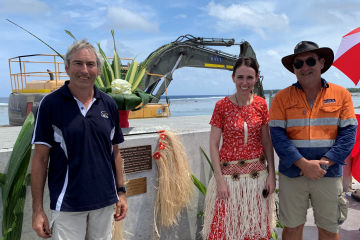Hall will mobilise to the remote nation – located approximately half-way between Australia and Hawaii – in early 2025 to construct a new seawall on behalf of the RMI Ministry of Public Works, Infrastructure and Utilities.
Hall Contracting CEO & Director Cameron Hall said with the majority of RMI’s land situated less than two metres above sea level, the new infrastructure would help to protect residents from rising sea levels and wave overtopping.
“As one of the world’s smallest and lowest-lying nations, RMI is extremely vulnerable to the impacts of climate change and severe weather events,” Mr Hall said.
“Climate projection modelling indicates that the global median sea level could rise between 0.43 metres and 0.84 metres by 2100*, bringing more frequent and intense coastal flooding, severe coastal erosion, and permanent submergence of some areas of the Marshall Islands.
“The new seawall will be constructed on the Ebeye atoll, using approximately 65,000 tonnes of armour rock to minimise erosion and greatly reduce inundation from storm surges.”
Mr Hall said Hall Contracting was well-versed in undertaking climate change adaptation works in low-lying Pacific Island nations, having recently delivered the first stage of the Tuvalu Coastal Adaptation Project.
“Our team has recently completed coastal protection works across three atolls in Tuvalu, including construction of a 7.8-hectare foreshore reclamation area and breakwater at Funafuti; a 665-metre-long berm top barrier at Nanumanga; and a seawall, berm top barrier and seven reef-top barriers at Nanumea.
“The works have provided new, elevated land for the Tuvaluan people and will help to safeguard community members and infrastructure against wave overtopping events for many years to come.
“We’re proud to be playing a role in helping protect our Pacific Island neighbours from the impacts of climate change, and we look forward to starting work on our first project in RMI.”
Hall Contracting will mobilise to Ebeye in January 2025 to commence the coastal protection works, which are being funded by the World Bank and Green Climate Fund.




